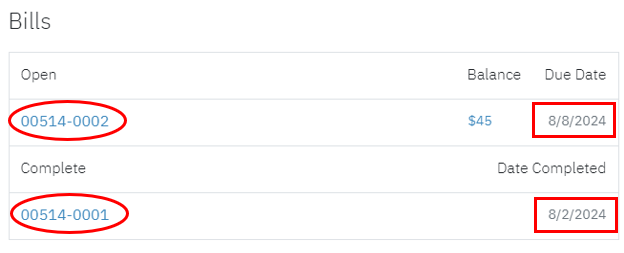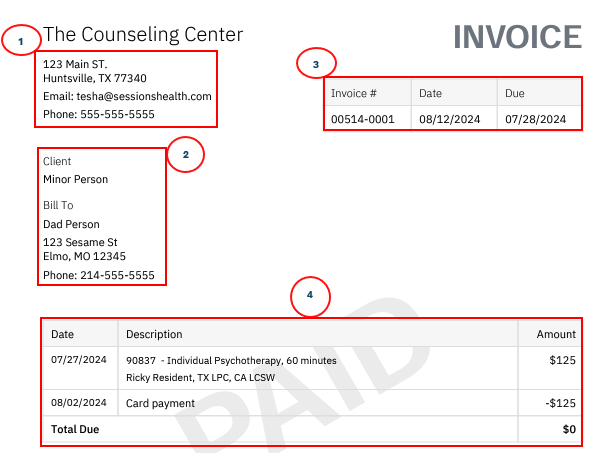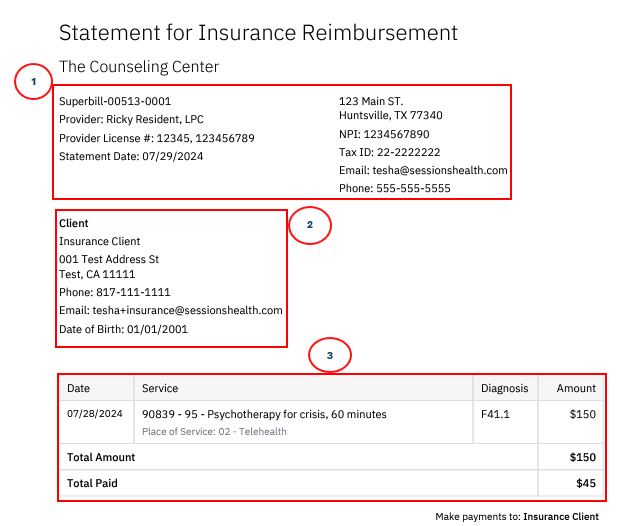Client Billing Management
This article explains how to view and understand billing-related documents, such as Bills, Statements and Superbills in the Client Portal.
- Viewing Bills in the Client Portal
- Open Invoice display
- Complete Invoice display
- Viewing Superbills
- Viewing a Billing Statement
Once logging into your client portal, you'll find the Billing tab as the last menu option at the top of your screen. Under the Billing tab, you may see sections such as Remaining Balance, Bills, Statements for Insurance Reimbursement, Billing Statements, My Payment Methods, and My Insurance Policies.
Note: The sections visible in your Client Portal may vary. If you don’t see a section you believe you should have access to, please reach out to your therapist for further assistance.
Viewing Bills in the Client Portal
Under the Bills section, you can view or pay Open (unpaid) invoices or see your history of Complete (paid) invoices. All Bills will be identified by a series of 9 digits referred to as the Invoice #, located on the left-hand side of each line item.
- Open bill line items will display the Balance (the dollar amount due) and the Due Date.
- Complete bill line items will display the Date Completed (the date the invoice was paid).
To view and/or pay an open bill, double-click the Invoice #, and a PDF of the invoice will open in a new window.
Note: See the Paying Invoices article for options on how to submit payments on open bills.

An Open Invoice will display:
- Provider’s name, address and contact information.
- The Client (person who received a service) and Bill To (person responsible for the bill).
- The Invoice #, current date, the bill’s Due date.
- A Pay Online link that takes you to an Online Bill Pay page where you can enter the Invoice # and Access Code to find and pay your invoice.
- Online Access Code - 6 digit number used to find and pay your invoice through the Pay Online link.
- Line Items will display:
- Date of service.
- Description of service code, type, duration and provider.
- Charges - Total service fee.
- Patient Amount - Amount owed.
- Total Due - breakdown of total charges and your owed amount.

To view a paid invoice, double-click the 9-digit Invoice # you wish to see in the Bills section under the Complete subheading.
A Complete Invoice will display:
- Provider’s name, business address and contact information.
- The Client (person who received a service) and Bill To (person responsible for the bill).
- The Invoice #, current date, the bill’s Due date.
- Line Items will display:
- Date of service and date payment was made.
- Description of service code, type, duration and provider.
- Amount billed or paid.
- Total Due - amount remaining, if any.

Viewing Superbills
A Statement for Insurance Reimbursement, also known as a Superbill, will appear in your Client Portal or in any profiles you manage once it has been shared by your therapist.
Each superbill will include a Superbill ID and the date it was sent for each line item. To view a Superbill, click on the Superbill ID on the left-hand side of the statement’s line item.

From there, a new window will open, giving you the option to print or download the superbill for your records. The statement will include the following details:
- Superbill ID, provider’s name, license(s) number, business address and contact information.
- Client’s name, address, contact information and date of birth.
- Date(s) of service, service description (including service code, type, duration, and place of service code), diagnosis, and service amount (total amount vs. total paid).

Viewing a Billing Statement
When a provider shares a billing statement via your client portal, it will become accessible under the Billing tab in the Billing Statements section. Each statement shared will have its own line item with an assigned Statement # on the left-hand side and the statement's date range on the right-hand side of the table.

You can open a billing statement by clicking the Statement # on the left-hand side of the table, which will open it as a PDF in a new tab. Once opened, the details on the billing statement will include:
- Statement Header: The 9-digit billing statement #, creation date, and the date range (the time period of services included).
- Provider's Information: Name, business address and contact information.
- Client’s Information: Name, address, contact information and date of birth.
- Statement Summary: An overview of the account's activity, including:
- Beginning Balance: Prior outstanding balance
- Invoices: Total billed during the time period
- Payments: Amount paid towards the balance
- Ending Balance: Remaining amount due on the invoice
- Transactions Summary: An itemized list of service and payment dates, descriptions of services or payments, and amounts, providing a detailed breakdown of all transactions.

